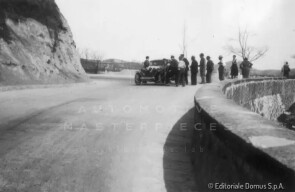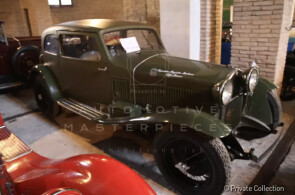
1931 Alfa Romeo 6C 1750 GT Mille Miglia
ON/OFF
Why am I an Automotive Masterpiece?
D. Remaining cars from extremely limited production runs
1 of 4 known
L. Limited edition cars
no. 4 manufactured. 1 of 4 known GT Mille Miglia manufactured without compressor.
In the early 1920s Vittorio Jano was entrusted by Alfa Romeo with the creation of a lightweight, high-performance vehicle to replace the large and heavy RL and RM models. The result was the Alfa Romeo 6C: a range of road, race, and sports cars produced between 1927 and 1954; the main steps being the 6C 1750 in 1929, the 6C 2300 in 1934 and the 6C 2500 in 1939. The "6C" designation refers to the number of cylinders in the car's straight-six engine. The bodies were crafted by renowned coachbuilders such as Castagna, James Young, Pininfarina, Touring, and Zagato. Starting in 1933, Alfa Romeo also offered an in-house body option, built at their Portello factory. The new 6-cylinder car was introduced in 1925 at the Salone dell'Automobile di Milano and officially produced from 1927 with the name 6C 1500, recalling the engine layout and displacement. This displacement choice was necessary, because the 2-liter formula leading Alfa Romeo to win the Automobile World Championship in 1925, had changed to 1.5-liter for the 1926 season.
The more powerful 6C 1750 was introduced in 1929 in Rome. The car featured a top speed of 95 mph (153 km/h), a chassis designed to flex over wavy surfaces, as well as sensitive geared-up steering. It was produced in six series between 1929 and 1933. Base model had a single overhead cam; Super Sport and Gran Sport versions had double overhead cam engine (DOHC) and a supercharger was available. Most of the cars were sold as rolling chassis and bodied by coachbuilders. The 1750 quickly gained a reputation for winning. In 1929, it won every major racing event it was entered, including the Grands Prix of Belgium, Spain, Tunis and Monza, as well as the Mille Miglia, with Giuseppe Campari and Giulio Ramponi. In 1930 it won again the Mille Miglia with Tazio Nuvolari and the Spa 24 Hours. Total production was of 2635 cars. The 6C 1750 Gran Turismo (4th and 5th series) replaced the 6C 1750 Sport 3rd series in 1930. Of this car it maintained the general approach: wheelbase, roadways and mechanical characteristics, while the power from the DOHC engine increased by 3 hp. Many minor mechanical changes were made, the most important being the increase in the diameter of the crankshaft pins, which up until then had retained the measurements of the 6C 1500.
This Alfa Romeo 6C 1750 GT, chassis no. 10914569, is one of the cars produced in 1931 and is a V series. The body was by Carrozzeria Touring, that built on the chassis a 2-door berlinetta “Weymann”. In the Weymann system the heavy metal sheets were replaced with waterproof pegamoid panels, applied on light wooden frames, which allowed to have a lightweight body and, at the same time, very silent. The lack of resistance over time of the pegamoid, which dried up, pushed the Touring technicians to find new solutions and led a few years later to the invention of the "Superleggera" construction system. Chassis no. 10914569 ran the 1933 Mille Miglia, ranking 17th overall and 1st in class with its owner-driver Giannangelo Sperti. An outstanding performance for a Sport-Touring car, moreover not equipped with a compressor. The car had an intense life in re-enactment events from early 1980s with the owner, the famed collector Mario Righini.






